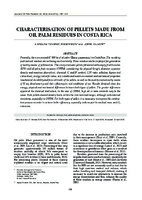Characterisation of pellets made from oil palm residues in Costa Rica

Fecha
2016Autor
Valaert, Jorre
Tenorio-Monge, Carolina
Moya-Roque, Róger
Metadatos
Mostrar el registro completo del ítemResumen
Presently, there are around 67 000 ha of oil palm (Elaeis guineensis) in Costa Rica. The resulting post-harvest residues are not being used currently. These residues can be employed for generation of heat by means of pelletisation. This study evaluates pellets fabricated with empty fruit bunches (EFB) and oil palm fruit mesocarp (OPFM), considering the physical (length, diameter, apparent density and moisture absorption), chemical (C and N content, C/N ratio, cellulose, lignin and extractives), energy (calorific value, ash, volatile and moisture content) and mechanical properties (mechanical durability and force at break) of the pellets, as well as the quality evaluation by means of X-ray densitometry and their efficiency in real conditions of use. Results obtained show few energy, physical and mechanical differences between both types of pellets. The greater differences appear at the chemical level where, in the case of OPFM, high oil or resin contents may be the cause. Both pellets showed density levels within the international ranges, although with internal variations, especially in OPFM. For both types of pellet, it is necessary to improve the combustion process in order to achieve better efficiency, especially with respect to residual mass and O2 emissions.
Descripción
Artículo científico
Fuente
Journal of Oil Palm ResearchCompartir
Métricas
Colecciones
- Artículos [37]

